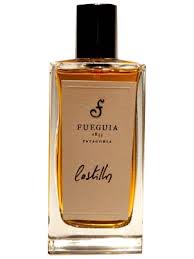Last Words: Three Final Fueguias
You would think, wouldn't you, that I would have gone to the Fueguia 1833 website before writing about any of the scents. I didn't, and one of the reasons is that a company's website is not usually the most reliable source of information: the other is that it just didn't occur to me until a couple of days ago. And when I did, I discovered that their online catalogue is a slightly insane 110 pages, and that they don't just have 18 scents in the line, as I assumed from the Luckyscent offering: they have over a thousand.
Not really! But they do have fifty-some — I think 54, but I may have lost count somewhere along the way, so let's say it's between 50 and 55, not counting the parfums d'ambience which exist only as room sprays and reed diffusers (amusingly called "cold candles") and such. And that is an insupportable number. Even the larger perfume houses took decades to build up anything close to that kind of catalogue: Fueguia 1833 has been in existence for three years. You cannot crank out that number of perfumes in that span of time and have all of them be good. Based on what I've tried from their line, you can't even have all of them be mediocre. The approach seems instead to be, "Throw everything at the wall and see what sticks."
So since Luckyscent isn't carrying the whole line, someone or someones actually chose the 18 scents they're carrying. Since the Luckyscent collection is a mishmash, no theme or consistency to the collection and frankly many of them no good at all, they're clearly not curated in any way: nobody sat down with the fifty-odd scents for a week or two and selected the best ones, that's for sure. I can't really think of any logical reason for the selections. I can think of some illogical ones, though.
1) The Luckyscent buyers didn't have the budget to carry the entire collection, but when they went to choose the scents they wanted to sell, they were overwhelmed by the number of options, so they printed out the catalogue, put it up on the wall, and threw darts at it.
2) When the first brightly coloured iMacs hit the market in 1999, there were five colours, but stores couldn't choose the colours they wanted, the ones they thought might sell better, not even when the initial sales figures were in and they knew that the Blueberry was a top seller and the Tangerine didn't move at all: they had to take the computers in packs of five, one of each colour. Perhaps the Fueguia people similarly told the Luckyscent people, "You get a third of them. This third. Take it or leave it."
3) Opera fans love stories about divas, the more scandalous the better. One of the milder (but still revealing) tales is of Australian opera diva Nellie Melba cynically telling contralto Clara Butt, about to embark on a tour of Australia, "Sing 'em muck! It's all they can understand!" Perhaps someone along the line decided that the Luckyscent approach should be, "Sell 'em muck! It's all they can understand, and they'll buy it anyway!"
Or perhaps realistically the Luckyscent subset is a completely random but otherwise accurate representation of the whole massive collection: half rubbish, a quarter acceptable, a quarter good to excellent. Whatever the actual story, I have three more Fueguias to get through, and here they are.
The list of notes for Lago del Desierto ("musk, lenga wood and coihue wood") doesn't even hint at its horribleness: meant to suggest a frozen lake, it smells largely of that unavoidable modernity, cheap freshness, plus unappealing musk and some indifferent wood, misleadingly not a complete atrocity at first but genuinely wretched after the first ten minutes or so, the kind of scent that you temporarily forget you're wearing until you catch a whiff of something dreadful and realize with a start that it's you.
What I expected from Castillos after reading the notes ("tuberose, jasmine, maté") is a big white floral, the sort of thing I usually hate, but that's not what it is: it opens beautifully as a soft, warm, creamy floral which tricks you into thinking it's going to be a soft, warm, creamy floral, and then suddenly takes a lurch into awfulness, which is presumably is due to the maté tea, a sharp, jangly, discordant note which turns everything very unpleasant. It stays unpleasant for about two hours, after which the base shows itself to be entirely acceptable if undistinguished, but of course by then it's too late. They couldn't just leave it as a pretty floral? There's nothing wrong with those: the world could probably use more of them these days.
A pulperia sounds as if it ought to be an orange-juice factory, but Fueguia already has a citrus scent, Humboldt, so instead Pulperia ("cedar, pepper, elemi") is a tarry, resiny cedar scent with a patchouli base, lingering, masculine, suggestive of other resin-heavy scents such as Eau de Fier. It is absolutely gorgeous; once again, as usual, too simple for its own good and far too expensive for what it is, but really a wonderful, desirable thing nonetheless.
Labels: Fueguia 1833

















